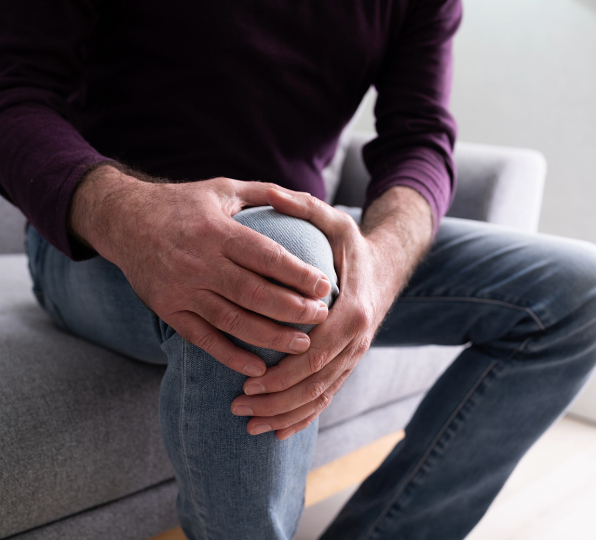Introduction:
Many people experience an increase in joint stiffness and discomfort as the temperature drops, which makes daily movements more difficult. Reduced mobility and a lower quality of life can result from the exacerbation of joint disorders such as arthritis and other inflammatory conditions during cold weather. Thankfully, there are a few tactics you can use to keep your joints flexible and less stiff throughout the winter. We’ll look at useful strategies and tactics in this blog to help relieve pain and maintain joint health during the winter.
1. Stay Active
Staying active is crucial for maintaining joint health and mobility, especially during colder weather when stiffness and discomfort may be more prevalent. Engaging in regular physical activity not only keeps your joints moving but also helps to reduce stiffness, improve flexibility, and alleviate discomfort. Incorporating a variety of low-impact exercises, stretching routines, and range-of-motion exercises into your daily routine can help you stay active and keep your joints healthy throughout the year.
Low-impact exercises are gentle on the joints while still providing an effective workout. Activities such as walking, swimming, cycling, yoga, and tai chi are excellent options for staying active without putting excessive strain on your joints. These exercises help to improve circulation, strengthen muscles, and promote overall joint health. Aim to incorporate at least 30 minutes of low-impact exercise into your daily routine to keep your joints moving and maintain flexibility.
In addition to low-impact exercises, stretching and range-of-motion exercises are essential for improving joint flexibility and preventing stiffness. Incorporate stretching exercises into your daily routine to target specific areas of tightness and discomfort. Focus on stretching the muscles surrounding the joints, such as the hamstrings, quadriceps, calves, shoulders, and hips, to improve flexibility and range of motion. Hold each stretch for 15-30 seconds, breathing deeply and slowly as you feel the tension release.
Range-of-motion exercises are another effective way to improve joint flexibility and mobility. These exercises involve moving your joints through their full range of motion to maintain flexibility and prevent stiffness. Incorporate exercises such as shoulder rolls, wrist circles, ankle circles, and knee bends into your daily routine to keep your joints flexible and mobile. Gradually increase the intensity and duration of these exercises as your joint mobility improves.
It’s essential to listen to your body and avoid overexertion, especially if you’re experiencing joint pain or discomfort. Start slowly and gradually increase the intensity and duration of your exercise routine as your joint health improves. If you experience any pain or discomfort during exercise, stop immediately and consult with a healthcare professional.
In addition to regular exercise, maintaining a healthy lifestyle can also contribute to joint health. Eat a balanced diet rich in fruits, vegetables, lean proteins, and whole grains to support overall joint health and reduce inflammation. Stay hydrated by drinking plenty of water throughout the day, as dehydration can contribute to joint stiffness and discomfort.
2. Keep Moving
Keeping your body in motion is essential for maintaining joint health and overall well-being, particularly if you have a sedentary lifestyle or spend prolonged periods sitting or standing. Incorporating a variety of gentle stretching exercises and low-impact activities into your daily routine can help keep joints flexible, lubricated, and free from stiffness and discomfort.
Engaging in regular stretching exercises is crucial for maintaining joint flexibility and preventing stiffness. Focus on gentle stretches that target key areas of the body, such as the neck, shoulders, back, hips, and knees. These stretches help improve flexibility, reduce muscle tension, and increase blood flow to the joints, promoting overall joint health and mobility.
Practicing mind-body exercises such as yoga, tai chi, or Pilates can also be highly beneficial for joint health. These practices emphasize gentle movements, proper alignment, and mindful breathing techniques, helping to improve joint mobility, balance, and strength. Incorporating yoga poses, tai chi forms, or Pilates exercises into your routine can help alleviate joint stiffness, enhance flexibility, and promote relaxation and stress relief.
Yoga is a holistic practice that combines physical postures, breathwork, and meditation to promote flexibility, strength, and mental well-being. Many yoga poses focus on stretching and strengthening the muscles surrounding the joints, helping to improve mobility and reduce stiffness. By practicing yoga regularly, you can enhance joint health, alleviate discomfort, and increase overall flexibility and range of motion.
Tai chi is an ancient Chinese martial art that emphasizes slow, flowing movements and deep breathing. This gentle practice helps improve balance, coordination, and joint flexibility while promoting relaxation and stress reduction. Tai chi is suitable for individuals of all ages and fitness levels and can be particularly beneficial for those seeking to improve joint mobility and reduce stiffness.
Pilates focuses on strengthening the core muscles, improving overall body alignment, and enhancing joint stability and mobility. The controlled movements and emphasis on proper alignment in Pilates help stabilize the joints, reduce the risk of injury, and improve overall joint function. Incorporating Pilates into your routine can help strengthen muscles, improve flexibility, and promote better joint health and mobility.
In addition to incorporating stretching exercises and mind-body practices into your routine, it’s essential to take regular breaks throughout the day to stand up, stretch, and move around. Prolonged periods of sitting or standing can lead to stiffness and discomfort in the joints, so it’s crucial to periodically change positions and move your body to maintain joint flexibility and mobility.
3.Maintain Optimal Hydration
Maintaining optimal hydration is crucial for supporting joint health and overall well-being. Adequate hydration helps to keep joints lubricated and flexible, reducing the risk of stiffness and discomfort. By drinking plenty of water throughout the day, you can help to alleviate joint symptoms and promote joint mobility.
Water is essential for maintaining the health and function of the joints. It helps to lubricate the joints, cushioning them and reducing friction during movement. Proper hydration also supports the delivery of nutrients to the joints and the removal of waste products, helping to keep them healthy and functioning optimally.
To stay hydrated, aim to drink at least eight glasses of water per day, or more if you’re physically active or live in a hot climate. Keep a reusable water bottle with you throughout the day as a reminder to drink regularly. You can also incorporate hydrating foods such as fruits and vegetables into your diet, as they contain high water content and contribute to your overall fluid intake.
While water is the best choice for hydration, it’s essential to limit consumption of caffeinated and alcoholic beverages, as they can contribute to dehydration. Caffeine is a diuretic, meaning it increases urine production and can lead to fluid loss. Similarly, alcohol has a dehydrating effect on the body and can impair the body’s ability to regulate fluid balance. Limit your intake of caffeinated beverages such as coffee, tea, and soda, as well as alcoholic drinks, to support optimal hydration and joint health.
In addition to staying hydrated, it’s essential to maintain a healthy lifestyle to support joint health. Engage in regular physical activity to keep your joints flexible and strong, incorporating low-impact exercises such as walking, swimming, or cycling into your routine. Practice good posture and body mechanics to reduce strain on your joints, and be mindful of overuse or repetitive movements that can lead to joint injury.
Incorporating joint-friendly exercises such as yoga, tai chi, or Pilates can also help to improve joint mobility, balance, and strength. These gentle, low-impact practices focus on controlled movements, proper alignment, and breath awareness, promoting relaxation and stress relief while supporting joint health.
Finally, be proactive about managing any existing joint conditions or injuries. Follow your healthcare provider’s recommendations for treatment and rehabilitation, and don’t hesitate to seek medical attention if you experience persistent joint pain, swelling, or stiffness.
4. Support Joint Health with Nutrition
Supporting joint health through nutrition is a key aspect of managing joint pain and inflammation. By incorporating anti-inflammatory foods rich in omega-3 fatty acids, antioxidants, and vitamin D into your diet, you can promote joint mobility, reduce inflammation, and alleviate stiffness. Including a variety of nutrient-dense foods in your meals can provide the essential nutrients needed to support optimal joint health and function.
Omega-3 fatty acids are known for their anti-inflammatory properties, which can help to reduce joint pain and inflammation. Fatty fish such as salmon, mackerel, and sardines are excellent sources of omega-3s and can be included in your diet several times a week. If you follow a vegetarian or vegan diet, consider incorporating plant-based sources of omega-3s such as flaxseeds, chia seeds, walnuts, and hemp seeds into your meals.
Antioxidants help to neutralize harmful free radicals in the body, which can contribute to inflammation and joint damage. Including a variety of antioxidant-rich foods in your diet can help to protect your joints from oxidative stress and support overall joint health. Leafy greens such as spinach, kale, and Swiss chard are rich in antioxidants such as vitamins A, C, and E, as well as minerals like selenium and zinc. Berries such as blueberries, strawberries, and raspberries are also high in antioxidants and can be enjoyed fresh or added to smoothies, oatmeal, or yogurt.
Turmeric and ginger are two spices with potent anti-inflammatory properties that can help to reduce joint pain and inflammation. Incorporating these spices into your cooking can add flavor and nutritional benefits to your meals while supporting joint health. Turmeric can be used in curries, soups, and stir-fries, while ginger can be added to teas, smoothies, and marinades.
Vitamin D plays a crucial role in bone health and joint function, and deficiency has been linked to an increased risk of joint pain and inflammation. Fatty fish, egg yolks, and fortified foods such as milk, orange juice, and cereal are good dietary sources of vitamin D. Additionally, spending time outdoors in sunlight can help your body produce vitamin D naturally.
In addition to incorporating these specific foods into your diet, it’s essential to maintain a balanced and varied diet that includes a wide range of nutrients. Eating a diet rich in fruits, vegetables, whole grains, lean proteins, and healthy fats can provide the essential vitamins, minerals, and antioxidants needed to support joint health and overall well-being.
By focusing on incorporating anti-inflammatory foods rich in omega-3 fatty acids, antioxidants, and vitamin D into your diet, you can promote joint health, reduce inflammation, and alleviate stiffness. Including a variety of nutrient-dense foods in your meals and maintaining a balanced diet can help to support optimal joint function and improve overall quality of life.
5. Practice Stress Management
Practicing stress management techniques is crucial for maintaining joint health and reducing the exacerbation of joint stiffness and pain associated with chronic stress. By prioritizing stress-reducing activities such as meditation, deep breathing exercises, mindfulness, and relaxation techniques, you can support both your mental well-being and your joint health.
Chronic stress has been linked to increased inflammation in the body, which can worsen joint symptoms and contribute to pain and stiffness. Therefore, it’s essential to incorporate stress management strategies into your daily routine to mitigate the negative effects of stress on your joints.
Meditation is a powerful tool for reducing stress and promoting relaxation. By taking time to sit quietly and focus your attention on your breath or a specific mantra, you can calm the mind and cultivate a sense of inner peace. Regular meditation practice has been shown to reduce stress hormones in the body, decrease inflammation, and improve overall well-being.
Deep breathing exercises are another effective way to reduce stress and promote relaxation. By practicing deep breathing techniques such as diaphragmatic breathing or alternate nostril breathing, you can activate the body’s relaxation response and lower stress levels. Deep breathing exercises can be done anywhere and anytime, making them a convenient and accessible stress management tool.
Mindfulness involves being fully present in the moment and paying attention to your thoughts, feelings, and sensations without judgment. By practicing mindfulness meditation or incorporating mindfulness into daily activities such as eating, walking, or showering, you can cultivate greater awareness and reduce stress levels. Mindfulness has been shown to improve mood, reduce anxiety, and enhance overall well-being.
In addition to formal meditation and mindfulness practices, relaxation techniques such as progressive muscle relaxation, guided imagery, and visualization can help to reduce stress and promote relaxation. These techniques involve systematically tensing and relaxing different muscle groups in the body or imagining peaceful and calming scenes to induce a state of deep relaxation.
Setting aside time for self-care activities that promote relaxation and mental well-being is essential for managing stress and supporting joint health. Spending time in nature, engaging in hobbies, or connecting with loved ones can provide a much-needed break from the demands of daily life and help to restore balance to the body and mind.
6. Seek Professional Guidance
Seeking professional guidance from healthcare providers or physical therapists is essential for managing joint stiffness and improving overall joint function. These professionals can provide personalized recommendations and treatment options tailored to your specific needs and conditions, helping you effectively address joint-related concerns and enhance your quality of life.
Healthcare providers, such as primary care physicians, rheumatologists, or orthopedic specialists, can evaluate your joint health, assess any underlying medical conditions, and recommend appropriate interventions. They may suggest lifestyle modifications, prescribe medications to manage pain and inflammation, or refer you to other specialists for further evaluation and treatment.
Physical therapists play a crucial role in helping individuals manage joint stiffness and improve joint function through targeted exercises, manual therapy techniques, and education. A physical therapist can design a personalized exercise program to strengthen muscles surrounding the affected joints, improve flexibility, and enhance overall joint stability and mobility. They can also teach you proper body mechanics and ergonomic principles to minimize stress on your joints during daily activities.
In addition to conventional medical treatments and physical therapy, exploring alternative therapies can also be beneficial for relieving joint stiffness and improving overall joint function. Alternative therapies such as acupuncture, chiropractic care, massage therapy, and hydrotherapy may offer additional options for managing joint-related symptoms and promoting joint health.
Acupuncture involves the insertion of thin needles into specific points on the body to stimulate energy flow and promote healing. This ancient practice has been used for centuries to alleviate pain, reduce inflammation, and improve joint mobility in conditions such as osteoarthritis and rheumatoid arthritis.
Chiropractic care focuses on the relationship between the spine and nervous system and aims to restore proper alignment and function to the musculoskeletal system. Chiropractic adjustments and manual manipulations can help relieve joint stiffness, improve range of motion, and alleviate pain associated with joint dysfunction.
Massage therapy involves the manipulation of soft tissues to reduce muscle tension, improve circulation, and promote relaxation. Targeted massage techniques can help alleviate joint stiffness, improve flexibility, and enhance overall joint function.
Hydrotherapy, or water therapy, involves exercises and activities performed in a pool or aquatic environment. The buoyancy of water reduces stress on the joints, making it an excellent option for individuals with joint stiffness or mobility limitations. Hydrotherapy exercises can help improve joint flexibility, strength, and range of motion while providing a low-impact and therapeutic environment for rehabilitation.


Conclusion:
Adding moringa leaves to your diet is a simple and effective way to boost your intake of essential nutrients and support your overall health and wellness. Whether you prefer moringa leaf powder, tea, salads, pesto, smoothies, or soups, there are countless delicious ways to incorporate this superfood into your daily meals. Experiment with different recipes and enjoy the incredible health benefits of moringa leaves as you embark on a journey to better nutrition and vitality.












